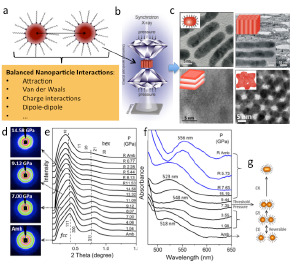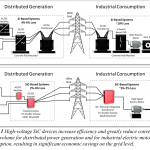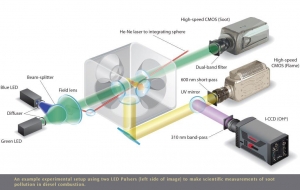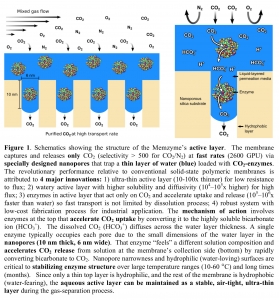Supporting the Scientific Base for Competencies Essential to Sandia Missions

The DOE Office of Science (SC) is the single largest supporter of basic research in the physical sciences in the U.S., providing more than 40 percent of total funding in this area. Sandia has active research programs funded by:
The focus of Sandia’s ARPA-E program is to establish partnerships with universities, industry and other National Labs to create innovative energy solutions for the Nation through both maturation of industry capabilities and commercialization of our technologies.
- Address Stationary and Transportation Energy pillars
- Leverage differentiating facilities/capabilities and Research Foundations of Sandia Labs
Research Highlights
Sandia receives ARPA-e funding to monitor plant roots for drought and heat tolerance
Multi-Modal Monitoring of Plant Roots for Drought and Heat Tolerance in the U.S. Southwest – $2,400,000
The Sandia National Laboratories team will develop a set of technologies to link below ground carbon partitioning with aboveground photosynthetic measurements. They will use microneedle sensor technology, originally developed for medical applications such as glucose level monitoring, to non-destructively measure the transport and composition of plant sap and products of photosynthesis in the field. In addition, they will measure the soil chemistry near the root zone with a micro-gas chromatograph, a device used to separate and analyze individual compounds. Using data analytics and modeling, they will link these measurements together to find aboveground proxies for below ground processes. If successful, the project will allow for the selection of improved sorghum varieties with increased root biomass without excavation of roots.
View the full release or learn more about the Rhizosphere Observations Optimizing Terrestrial Sequestration ROOTS) projects here.
Controlled Self-Assembly in Ternary Polymers

Top Left: Schematic of ternary polymer monolayers. Top Right: AFM images of experimental systems, at different polymer fractions, compared with corresponding SCFT calculations. Bottom: phase diagram.
Scientific Achievement
By creating a dense layer with three types of polymer molecules bound to a surface, we have demonstrated unique self-assembled patterns both theoretically and experimentally.
Significance and Impact
Programmable polymer domains can be used to template novel electronic or photonic material, for example to precisely place quantum dots for controlled energy transfer. Polymer domains on nanoparticles can control their assembly to create new responsive materials.
Research Details
- Self-consistent field theory (SCFT) was used to calculate the self-assembled patterns and phase diagram for ternary mixtures of surface-bound polymers.
- Ternary polymer monolayers were synthesized by polymerizing from a surface and shown to form laterally-phase separated domains in agreement with theory.
Pressure-Directed Assembly: new opportunity for nanoscience
(Fred Kavli Distinguished Lectureship in Nanoscience award presentation by Hongyou Fan at the 2015 MRS Spring Meeting)

Pressure modulates balanced interactions in self-assembled nanoparticle arrays (a), enables formation of 1-3 dimensional nanostructures (c). In-situ structural (d,e) and optical (f) interrogation show correlation and consistency with phase transition processes (e,g) and formation of the nanostructures (c).
Scientific Achievement
Pressure-Directed Assembly modulates nanoparticle interactions, enables ‘reversible and adjustable’ mesoscale assembly and exploration of collective physical characteristics for design and fabrication of novel nanoelectronic and photonic materials.
Significance and Impact
Exerting pressure-dependent control over nanoparticle arrays provides a unique and robust system to understand collective physics and to control optical property and energy transfer (Au, Ag, CdSe, FePt, etc.).
Research Details
–Below threshold pressure, the interparticle spacing and resulting surface plasmon coupling were systematically and reversibly tuned.
Above threshold pressure, nanoparticles consolidated into 1-3 dimensional novel nanoelectronic and photonic materials (e.g., nanorods, nanowires, nanosheets, etc.)
2016 ARPA-e Energy Innovation Summit
Meet our Scientists!
Stop by the main Sandia Labs Booth #505 for an opportunity to interact with SNL scientists including:
- Eric Langlois, R&D, Electronics Engineer, MEMS Technology Department
- Jeff Nelson, Senior Manager, Semiconductor and Optical Sciences Department
- Erik Spoerke, R&D, Material Science, Electronic, Optical & Nano Materials Department
Sandia Labs Featured in the Technology Showcase
Sandia Lab / Booth #505
Through the Secure and Sustainable Energy Future Mission Area, Sandia National Laboratories seeks to support the creation of a secure energy future for the US by using its capabilities to enable an uninterrupted and enduring supply of energy from domestic sources, and to assure the reliability and resiliency of the associated energy infrastructure. SNL seeks to create an energy future that is also sustainable by using its capabilities to drive the development and deployment of energy sources that are safer, cleaner, more economical and efficient, and less dependent on scarce natural resources.
Demonstrations:
Monday, February 29, 2016
- 4:30-5:45 PM—Eric Langlois, MagSense PV
- 5:45-7:00 PM—Jeff Nelson, Hydrocarbon Membranes for Energy and Water Electrochemical Systems
Tuesday, March 1, 2016
- 12:00-1:30 PM—Jeff Nelson,Hydrocarbon Membranes for Energy and Water Electrochemical Systems
- 5:00-6:15 PM—Eric Langlois, MagSense PV
- 6:15-7:00 PM—Erik Spoerke, Sodium-Based Battery Development
Wednesday, March 2, 2016
- 12:00-2:00 PM—Erik Spoerke, Sodium-Based Battery Development

ARPA-e Award-Winning Technology Booth # 841
Accelerating Low-cost Plasma Heating and Assembly (ALPHA) Project
Demonstrating Fuel Magnetization and Laser Heating Tools for Low-Cost Fusion Energy
Partners: University of Rochester
Project Innovation + Advantages:
Sandia National Laboratories is partnering with the Laboratory for Laser Energetics at the University of Rochester to investigate the behavior of the magnetized plasma under fusion conditions, using a fusion concept known as Magnetized Liner Inertial Fusion (MagLIF). MagLIF uses lasers to pre-heat a magnetically insulated plasma in a metal liner and then compresses the liner to achieve fusion. The research team will conduct experiments at Sandia’s large Z facility as well as Rochester’s OMEGA facilities, and will collect key measurements of magnetized plasma fuel including temperature, density, and magnetic field over time. The results will help researchers improve compression and heating performance. By using the smaller OMEGA facility, researchers will be able to conduct experiments more rapidly, speeding the learning process and validating the MagLIF approach. Sandia’s team will also use their experimental results to validate and expand a suite of simulation and numerical design tools to improve future fusion energy applications that employ magnetized inertial fusion concepts. This project will help accelerate the development of the MagLIF concept, and assist with the continued development of intermediate density approaches across the ALPHA program.
OPEN 2015 PROJECT SELECTIONS
50 MW Segmented Ultralight Morphing Rotors for Wind Energy
Sandia has partnered with a team led by the University of Virginia will design a 50 Megawatt (MW) wind turbine featuring downwind morphing to reduce blade loads and allow ultralight segmented blades. They will also build and field test an aeroelastically-scaled version to demonstrate this novel technology. The 50 MW turbine design could enable a 10x increase in power compared to today’s largest production turbines. The 200-meter long blades can be fabricated in five to seven segments, and assembled at the point of use. The hurricane-resistant design can enable low-cost, offshore wind energy for the United States.
Sandia Labs ARPA-e Award News:
Sandia’s Energy & Climate Program wins R&D 100 awards
The annual R&D 100 Awards, also dubbed the “Oscars of Invention,” celebrate the world’s best applied technology resulting from research and development by industry, academia, and government-sponsored entities. Once again, Sandia National Laboratories has earned its place on the list of winners, this year with 3 of its 5 awards (see below) related to Energy and Climate. R&D 100 Awards signify and support the value of our Energy and Climate mission by recognizing the applications of our extensive research efforts directed at solving pressing energy, climate, and energy infrastructure problems.
 Sandia and United Silicon Carbide, Inc., create new high voltage switch
Sandia and United Silicon Carbide, Inc., create new high voltage switch
Rising global energy usage has placed unprecedented demands on an aging electrical grid that must be revolutionized not only to become more efficient, but also to become more reliable through the integration of renewables and energy storage systems. To achieve greater reliability, next-generation power-conversion technology will use high-voltage SiC (silicon carbide) devices to reduce switching losses, or energy dissipation, throughout a system. United Silicon Carbide, Inc., and Sandia National Laboratories’ 6.5-kV SiC device and power module—the 6.5kV Enhancement-Mode Silicon Carbide JFET Switch—represents a high-voltage module based on reliable, normally-off SiC JFETs (junction field-effect transistors). This on/off switch is 20 times more effective at reducing switching losses and exhibits the fastest turn-on and turn-off of any similarly rated power module.
Bright future for low-cost LED Pulser invention
Sandia’s LED Pulser invention is a low-cost, high-brightness, fast-pulsed, multi-color light-emitting diode (LED) driver. The technology uses custom electronic circuitry to drive high-power LEDs to generate light pulses with shorter duration, higher repetition frequency, and higher brightn
LED Pulser invention is a low-cost, high-brightness, fast-pulsed, multi-color light-emitting diode (LED) driver. The technology uses custom electronic circuitry to drive high-power LEDs to generate light pulses with shorter duration, higher repetition frequency, and higher brightn ess than commercial off-the-shelf systems. A single device can emit up to four different colors, each with independent pulse timing. The four colors are emitted from a nearly coincident source area, a feature crucial for creating light beams in many optical applications. The pulser’s capabilities have enabled various science, engineering, and R&D applications otherwise possible only with far more expensive light sources and optics.
ess than commercial off-the-shelf systems. A single device can emit up to four different colors, each with independent pulse timing. The four colors are emitted from a nearly coincident source area, a feature crucial for creating light beams in many optical applications. The pulser’s capabilities have enabled various science, engineering, and R&D applications otherwise possible only with far more expensive light sources and optics.
 Cost-Effective Carbon Capture
Cost-Effective Carbon Capture
In his 2015 State-of-the-Union address, President Obama said, “No challenge poses a greater threat to future generations than climate change.” To confront the immediate grand challenge of efficient carbon capture to mitigate climate change, Sandia National Laboratories and the University of New Mexico designed the CO2 Memzyme, a significant advance in gas separation technology. The new memzyme surpasses earlier polymeric membrane technology by capturing more carbon dioxide, faster, from a gas mixture while simultaneously producing nearly pure carbon dioxide (99%) for industrial re-use. The memzyme is the the first technology that meets or exceeds U.S. Department of Energy targets for cost-effective carbon capture. This invention also won the R&D 100 contest’s Green Technology Special Recognition Gold Award.




